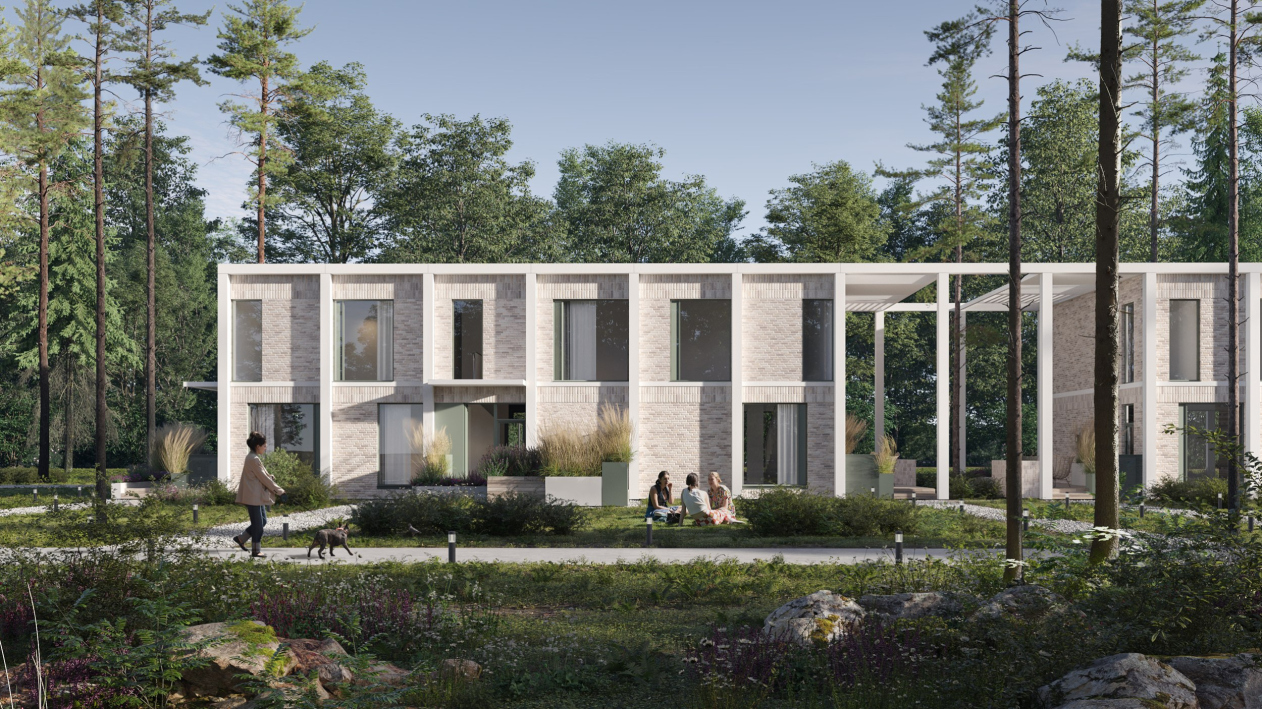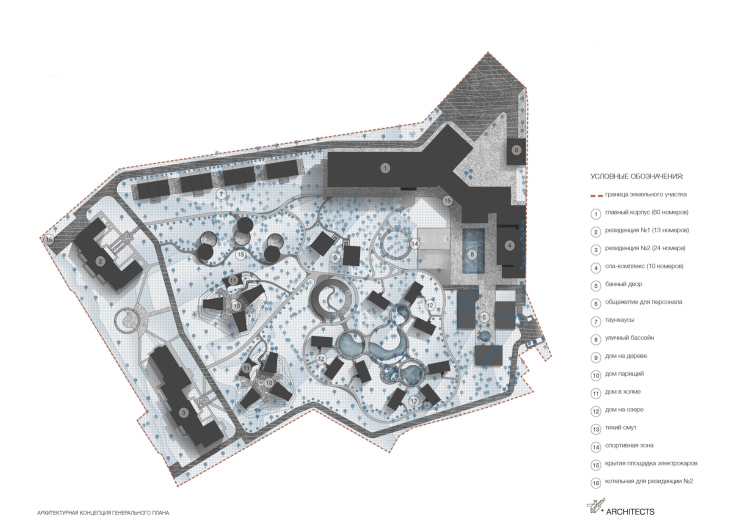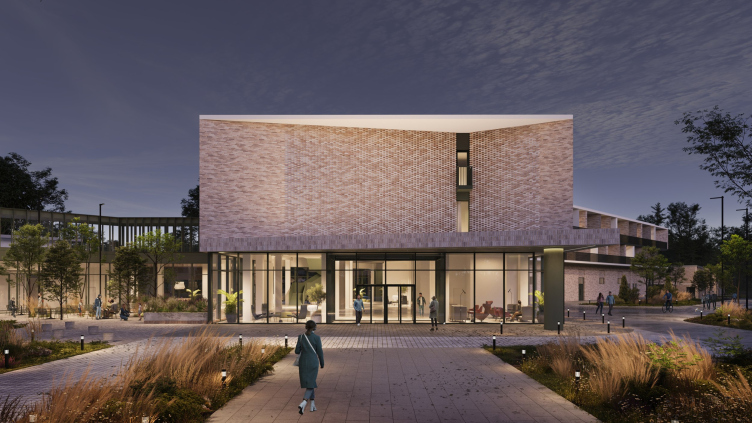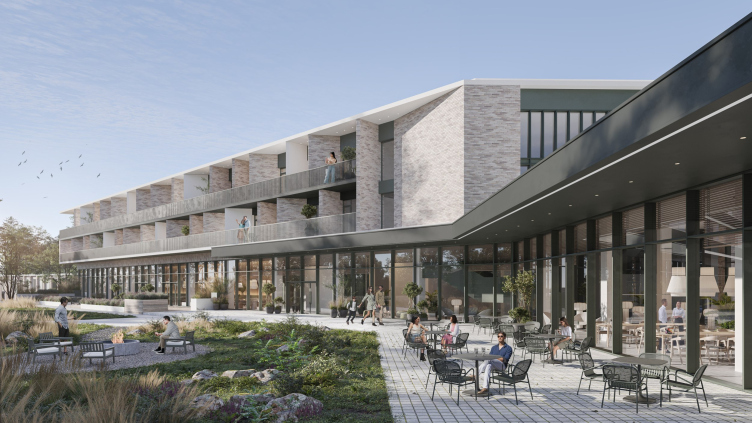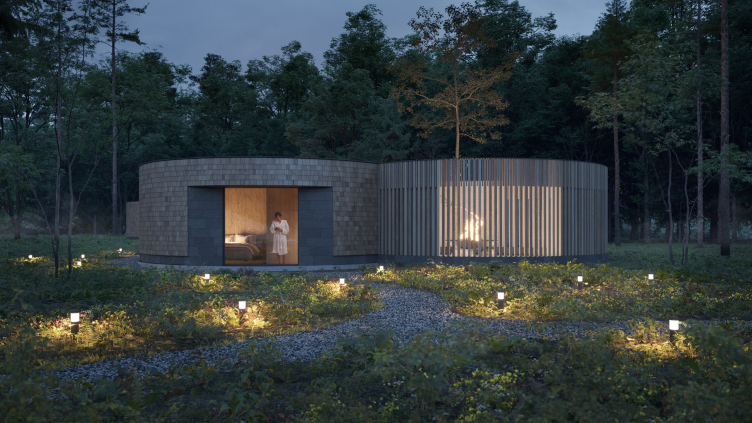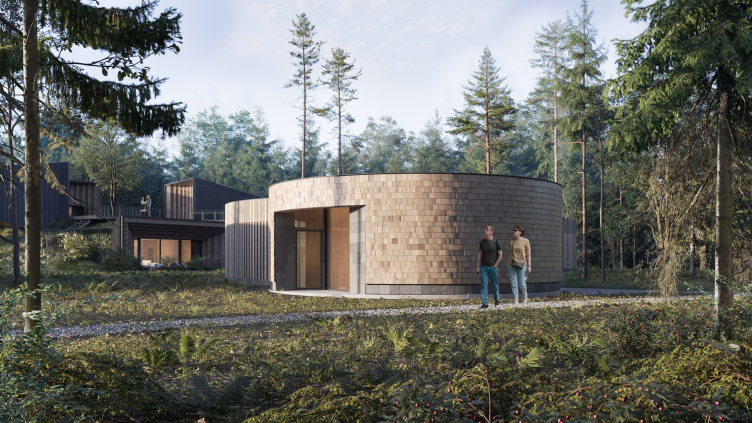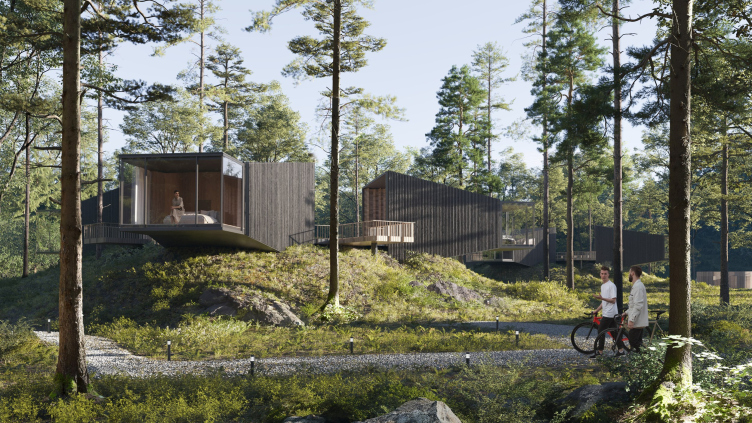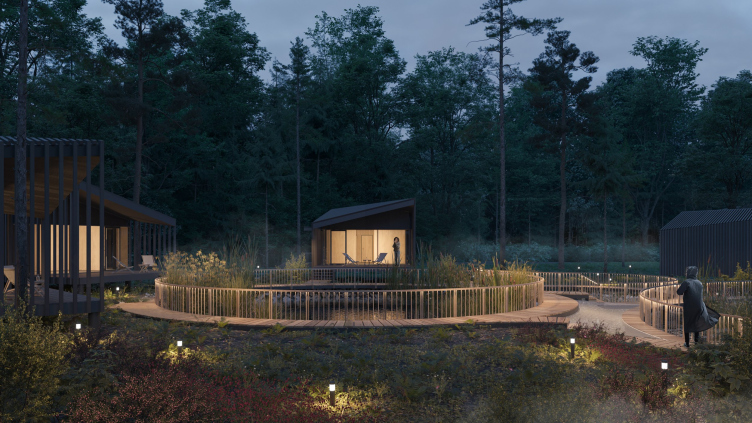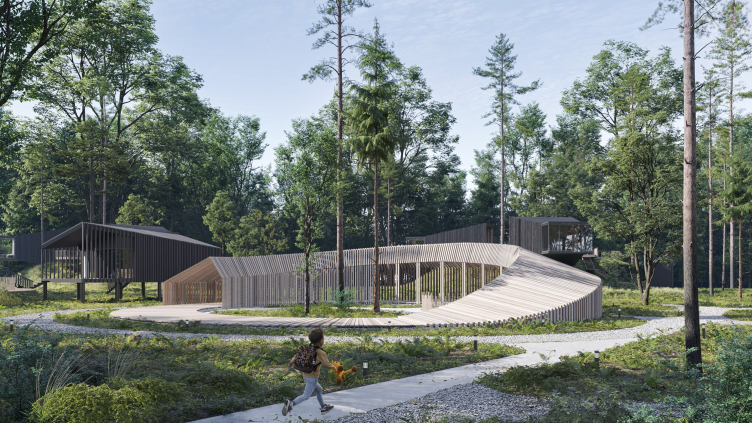Over time, the approach to developing this prestigious location has changed rapidly and sometimes quite dramatically. Initially, two luxurious residences in a classic style were built here, but they never found private owners. About a year ago, the plot along with the buildings was acquired by the development and investment company Rentaved, which decided to develop it with serial barnhouses, adding treehouses as a highlight.
But then the company ultimately took a different, more exclusive path – it retained the idea of diverse housing formats, i.e., room typologies, but decided to make them original – like, for example, in Yasnopole, Pirogovo, or Veretievo. Then the development company turned to T+T Architects for assistance.
In joint discussions, a concept emerged: a picturesque park with six thematic zones, for each of which its own type of bungalow house is designed. The diversity should compel visitors to return – after trying a treehouse, they will want to experience living inside a hill or by the water. Additionally, the launch of a word-of-mouth campaign is ensured – such objects and experiences cannot be kept from sharing on social networks.
In addition to the picturesque forested park area, which guests can explore on foot or using electric cars, there will be a restaurant and a spa complex at the guests’ disposal. The hotel is primarily designed for adult leisure and hosting business events, conferences, and retreats.
Hotel complex in Zvenigorod
Copyright: © Т+Т Architects
The Heart of the Complex
The guests are welcomed by the main hotel building, which separates the territory from the external noise and the check-in hustle, and also consolidates the accompanying leisure services.
After leaving the car in the parking lot, the guest heads towards the entrance portal, where they symbolically cross the border of the mundane world and enter a special space that can be likened to either an enchanted forest or some sort of amusement park for adults: here, they can swim, stroll, gaze at the fire and stars, listen to the rustle of the trees, and experience new culinary delights. The glazing of the first floor makes this boundary transparent and seems to slightly draw back the curtain.
Hotel complex in Zvenigorod
Copyright: © Т+Т Architects
From the lobby, through a warm passage, one can enter the spa complex with pools and saunas. On the other side is the residential wing, on the first floor of which there is a co-working space and a restaurant with panoramic glazing.
The architectural solution of the hotel building is traditional for its typology. Long horizontals are emphasized by a “ribbon” fence and plastered cornices, while the rhythm is set by dividing loggias on pylons, turned at different angles. Inserts of green metal are used as accents. According to the architects, the inserts are intended to “connect the development with the forest environment and make the urban image look and feel more natural”.
The contradiction arising between the distinctly modern stylistics of the new buildings and the grandeur of the existing residences is resolved through a shared color palette. And furthermore, as the architects add: “The transition from the classical architectural style of the reconstructed residences to the main building, designed in a modern stylistic manner, is smoothened somewhat by a chain of blocked houses, which are connected to each other by colonnades with terraces inside”.
Hotel complex in Zvenigorod
Copyright: © Т+Т Architects
Suburbia
Along the northern border of the plot stretch townhouses designed for large groups or families. Four blocks of three units each are connected by a gallery, which sometimes becomes part of the facade and sometimes forms large portals that open forest views. The supports of the gallery complement the slender trunks of pine trees, for the unhindered growth of which “hatches” are made in the floor. The close proximity of artificial and natural “columns”, together with lush perennials and other additional plantings, creates a sense of the architecture being “captured” or “seized” by the landscape. This technique also produces a feeling of abundance and the power of nature, seemingly capable of nourishing people.
Hotel complex in Zvenigorod
Copyright: © Т+Т Architects
Hotel complex in Zvenigorod
Copyright: © Т+Т Architects
Similar to the hotel building, the architects use conventionally “urban” materials for cladding the townhouses – light brick, plaster, and the aforementioned green metal panels. The strict rhythm of the colonnade is occasionally disrupted by asymmetrically placed windows of different sizes. Thanks to the gaps between the blocks, the doors to the units are arranged in such a way that neighbors may not encounter each other face to face throughout their stay.
Hotel complex in Zvenigorod
Copyright: © Т+Т Architects
Hotel complex in Zvenigorod
Copyright: © Т+Т Architects
Together with the main building and the existing residences, the “suburbia” outlines the territory. All these buildings face the park, inside of which the “bungalows” are distributed. They no longer have “urban planning” tasks, so the architects choose wood as the main material and opt for more “freehand” spatial and compositional solutions.
The Quiet Pool
The closest to the suburbia are three round-plan cottages with flat roofs, adjacent to which are enclosed courtyards where one can cook over an open fire. This “sealed” layout allows for a sense of seclusion. The façade of the residential part is clad in light Klinker, while the entrance groups and window portals are decorated with basalt tiles.
Hotel complex in Zvenigorod
Copyright: © Т+Т Architects
Hotel complex in Zvenigorod
Copyright: © Т+Т Architects
Alpine Village
The next endeavor involves two artificial hills, into which “cave houses” or “houses in the hill” are embedded, with an entrance in the form of a narrowing wooden “funnel” and an outward-facing panoramic terrace. “The exterior wall of the house is made of panoramic glazing to provide the necessary illumination and unity with nature, while the terrace canopy ensures privacy from prying eyes and casts shade on a hot day” explains Sofia Burmistrova, head of the architectural department at T+T.
At the summit of each hill, there are three “hovering houses”, whose silhouette also resembles a funnel. In the narrow part of each house, there are cantilevered bedrooms, while the entrances are in the wider part; in this direction, the houses expand with welcoming flares, and the facades, facing each other and the neighboring mini-square, are designed as arched recesses formed by voluminous ornaments made of light wood shingles.
Hotel complex in Zvenigorod
Copyright: © Т+Т Architects
The Lakeland
Nine houses with gable roofs, panoramic windows, and terraces facing the water are grouped around artificial ponds. Along the wooden decking that connects all three lakes in a circular route, one can reach a minimalist playground reminiscent of a Möbius strip.
Hotel complex in Zvenigorod
Copyright: © Т+Т Architects
Hotel complex in Zvenigorod
Copyright: © Т+Т Architects
Hotel complex in Zvenigorod
Copyright: © Т+Т Architects
Swallow Nests
For those who care about their inner child, two “treehouses” are installed in the preserved forest area. Not a single pine tree was harmed; seven-meter metal piles with welded frames, camouflaged at the foundation level with fertile soil, serve as supports. To reach the house, whose shape and cladding are inspired by swallow nests, one can use a spiral staircase. Hammocks are suspended from the piles, and in the evening, lighting reminiscent of a swarm of fireflies illuminates them.
Hotel complex in Zvenigorod
Copyright: © Т+Т Architects
Despite the diverse formats, all buildings contribute to the overall concept – a natural park that also accommodates architectural experiences. In part, it resembles an open-air museum – like Vitoslavitsy near Veliky Novgorod or Vasilevo near Torzhok, where wooden structures from different eras are collected. Partly, it draws on the success of projects like Nikola-Lenivets. And, of course, it reflects the demand for an environment that doesn’t dominate nature but delicately integrates with it.

